Digital Technologies Determination Effectiveness for the Productivity of Organic Winter Wheat Production in Low Soil Performance Indicator
Abstract
:1. Introduction
2. Materials and Methods
2.1. Experimental Design and Execution Plan
2.2. The Assessment of Meteorological Conditions
2.3. Determination of Soil and Winter Wheat of Variety Skagen Grain Quality and Productivity
2.4. Statistical Analysis
3. Results and Discussion
3.1. Assessment of Dynamic of Soil Agrochemical Properties and Winter Wheat of Variety Skagen Grain Crude-Protein Dependence on Soil Texture
3.2. Productivity of Winter Wheat of Variety Skagen
4. Conclusions
Author Contributions
Funding
Institutional Review Board Statement
Informed Consent Statement
Conflicts of Interest
References
- Baltrėnaitė, E.; Baltrėnas, P.; Lietuvninkas, A. Biogeochemical Aspect of Metal Uptake by Trees. In The Sustainable Role of the Tree in Environmental Protection Technologies; Springer: Cham, Switzerland, 2016; pp. 81–126. [Google Scholar]
- Budnakova, M.; Čermak, P. Fertilising recommendation system based on results of agrochemical soil testing. Fertil. Fertil. 2009, 37, 149–159. [Google Scholar]
- Abdulhakim, M.A.; Romain, C.; William, S.H.; Zhanzhang, C.; Niklas, B.O.; Henrik, G.S.; Lars, E.; Johan, E. Biodiversity decline with increasing crop productivity in agricultural fields revealed by satellite remote sensing. Ecol. Indic. 2021, 130, 108098. [Google Scholar]
- Mažvila, J.; Staugaitis, G.; Adomaitis, T.; Arbačiauskas, J.; Vaišvila, Z.; Šumskis, D. Agrochemical properties of Lithuanian soils and their changes after regaining independence. Žemės Ūkio Moksl. 2008, 15, 13–21. [Google Scholar]
- Tripolskaja, L.; Mašauskas, V.; Adomaitis, T.; Karčiauskienė, D.; Vaišvila, Z. Managment of Agroecosystem Components; Lithuanian Research Centre for Agriculture and Forestry: Kaunas, Lithuania, 2010; p. 568. (In Lithuanian) [Google Scholar]
- Toigildin, A.; Kulikov, Y.; Toigildina, I.; Aypov, D.; Nikiforova, S.; Ibragimova, C. Geographic Information Systems in Forecasting the Winter Wheat Yield. In XIV International Scientific Conference “Interagromash 2021"; Springer: Cham, Switzerland, 2021; pp. 322–329. [Google Scholar]
- Besaliev, I.N.; Bolodurina, I.P.; Parfenov, D.I.; Akimov, S.S. Development of a digital model for assessing the influence of agroecological factors on the productivity of wheat grains. In IOP Conference Series: Earth and Environmental Science; IOP Publishing: Bristol, UK, 2021; Volume 624, p. 012214. [Google Scholar]
- Staugaitis, G.; Šumskis, D. Spatial variability of pH as influenced by different soil sampling methods and geostatistical techniques. Žemdirbystė 2011, 98, 323–332. [Google Scholar]
- Staugaitis, G.; Vaišvila, Z. Soil Agrochemical Research; Lithuanian Research Centre for Agriculture and Forestry: Kaunas, Lithuania, 2019; p. 111. (In Lithuanian) [Google Scholar]
- Schut, A.G.T.; Traore, P.C.S.; Blaes, X.; de By, R.A. Assessing yield and fertilizer response in heterogeneous smallholder fields with UAVs and satellites. Field Crops Res. 2018, 221, 98–107. [Google Scholar] [CrossRef]
- Rasmussen, J.; Ntakos, G.; Nielsen, J.; Svensgaard, J.; Poulsen, R.N.; Christensen, S. Are vegetation indices derived from consumer-grade cameras mounted on UAVs sufficiently reliable for assessing experimental plots? Eur. J. Agron. 2015, 74, 75–92. [Google Scholar] [CrossRef]
- Wang, Y.; Zhang, Z.; Feng, L.; Du, Q.; Runge, T. Combining multi-source data and machine learning approaches to predict winter wheat yield in the conterminous united states. Remote Sens. 2020, 12, 1232. [Google Scholar] [CrossRef] [Green Version]
- Taghizadeh-Mehrjardi, R.; Nabiollahi, K.; Rasoli, L.; Kerry, R.; Scholten, T. Land suitability assessment and agricultural production sustainability using machine learning models. Agronomy 2020, 10, 573. [Google Scholar] [CrossRef]
- Ajami, M.; Heidari, A.; Khormali, F.; Zeraatpisheh, M.; Gorji, M.; Ayoubi, S. Spatial variability of rainfed wheat production under the influence of topography and soil properties in loess-derived soils, northern Iran. Int. J. Plant Prod. 2020, 14, 597–608. [Google Scholar] [CrossRef]
- Koroleva, P.; Dolinina, E.; Rukhovich, A. Comparative analysis of the yield map obtained from the John Deere combine and the ASF-index distribution map. Int. Multidiscip. Sci. GeoConference SGEM 2020, 20, 191–198. [Google Scholar]
- Kulyanitsa, A.L.; Rukhovich, D.I.; Koroleva, P.V.; Vilchevskaya, Y.V.; Kalinina, N.V. Analysis of the Informativity of Big Satellite Precision-Farming Data Processing for Correcting Large-Scale Soil Maps. Eurasian Soil Sci. 2020, 53, 1709–1725. [Google Scholar] [CrossRef]
- Nabiollahi, K.; Heshmat, E.; Mosavi, A.; Kerry, R.; Zeraatpisheh, M.; Taghizadeh-Mehrjardi, R. Assessing the influence of soil quality on rainfed wheat yield. Agriculture 2020, 10, 469. [Google Scholar] [CrossRef]
- Kayad, A.; Sozzi, M.; Gatto, S.; Whelan, B.; Sartori, L.; Marinello, F. Ten years of corn yield dynamics at field scale under digital agriculture solutions: A case study from North Italy. Comput. Electron. Agric. 2021, 185, 106126. [Google Scholar] [CrossRef]
- Juostas, A.; Jotautiene, E. Evaluation of combine harvester parameters using manual and auto-steering modes. In Proceedings of the Engineering for Rural Development: 20th International Scientific Conference, Jelgava, Latvia, 26–28 May 2021; Latvia University of Life Sciences and Technologies: Jelgava, Latvia, 2021. [Google Scholar]
- Řezník, T.; Pavelka, T.; Herman, L.; Lukas, V.; Širůček, P.; Leitgeb, Š.; Leitner, F. Prediction of Yield Productivity Zones from Landsat 8 and Sentinel-2A/B and Their Evaluation Using Farm Machinery Measurements. Remote Sens. 2020, 12, 1917. [Google Scholar] [CrossRef]
- Czarnecki, W.M.; Podolak, I.T. Machine learning with known input data uncertainty measure. In Proceedings of the IFIP International Conference on Computer Information Systems and Industrial Management, Krakow, Poland, 25–27 September 2013. [Google Scholar]
- Steel, R.G.D.; Torrie, J.H. Principles and Procedures of Statistics. In A Biometrical Approach, 2nd ed.; McGraw-Hill: New York, NY, USA, 1980. [Google Scholar]
- Stevens, D.R.; Thompson, B.R.; Johnson, P.; Welten, B.; Meenken, E.; Bryant, J. Integrating Digital Technologies to Aid Grassland Productivity and Sustainability. Front. Sustain. Food Syst. 2021, 5, 99. [Google Scholar] [CrossRef]
- Diacono, M.; Trinchera, A.; Montemurro, F. An Overview on Agroecology and Organic Agriculture Strategies for Sustainable Crop Production. Agronomy 2021, 11, 223. [Google Scholar] [CrossRef]
- Russell, B.; Guzman, C.; Mohammadi, M. Cultivar, trait and management system selection to improve soft-red winter wheat productivity in the eastern United States. Front. Plant Sci. 2020, 11, 335. [Google Scholar] [CrossRef] [PubMed]
- Liu, Y.; Zhang, X.; Xi, L.; Liao, Y.; Han, J. Ridge-furrow planting promotes wheat grain yield and water productivity in the irrigated sub-humid region of China. Agric. Water Manag. 2020, 231, 105935. [Google Scholar] [CrossRef]
- Karampoiki, M.; Heiß, A.; Sharipov, G.M.; Mahmood, S.; Todman, L.C.; Murdoch, A.J.; Griepentrog, H.W.; Paraforos, D.S. Producing grain yield maps by merging combine harvester and remote sensing data. In Precision Agriculture’21; Wageningen Academic Publishers: Wageningen, The Netherlands, 2021; pp. 377–402. [Google Scholar]
- Zhou, X.; Kono, Y.; Win, A.; Matsui, T.; Tanaka, T.S. Predicting within-field variability in grain yield and protein content of winter wheat using UAV-based multispectral imagery and machine learning approaches. Plant Prod. Sci. 2021, 24, 137–151. [Google Scholar] [CrossRef]
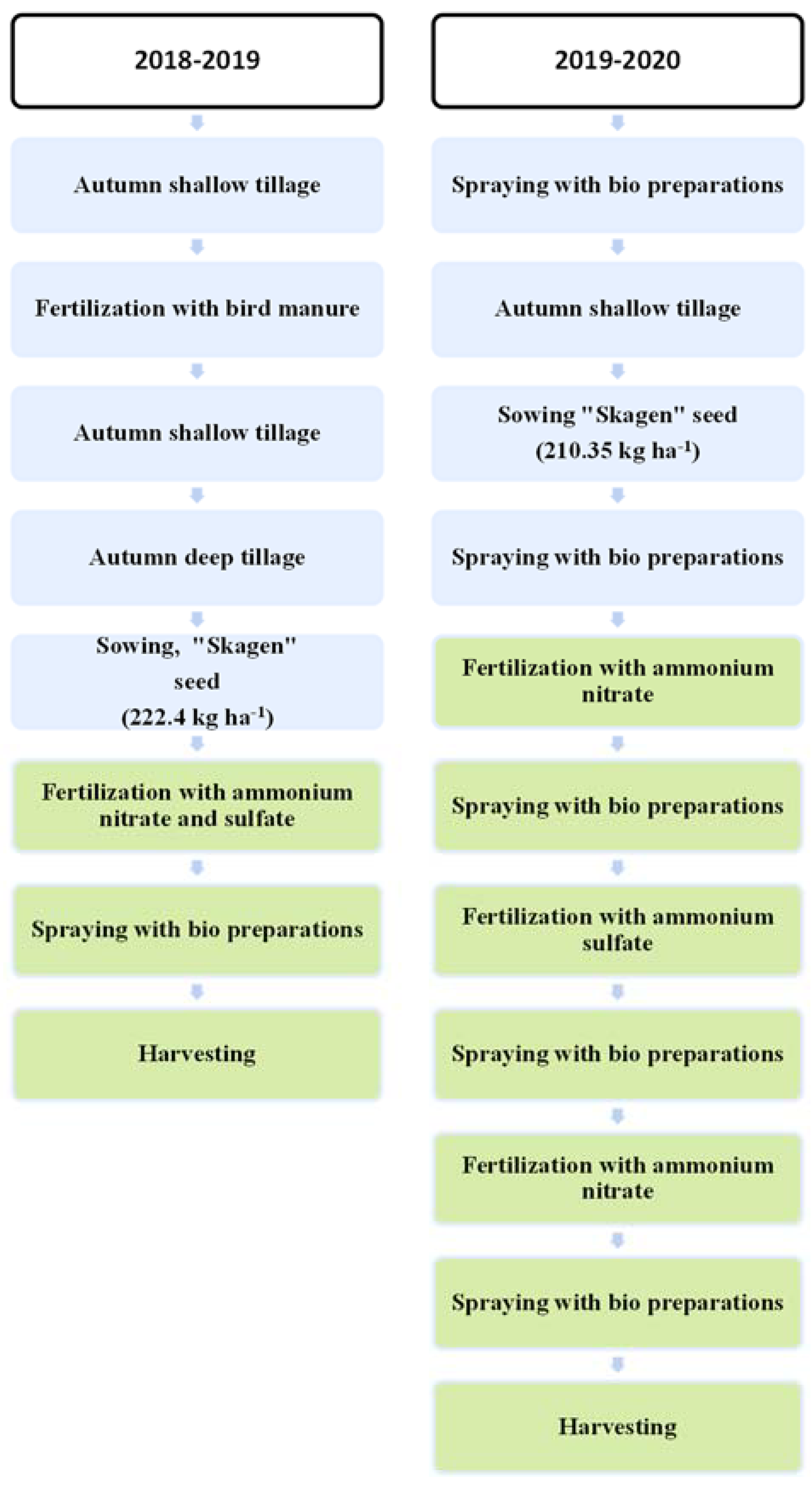

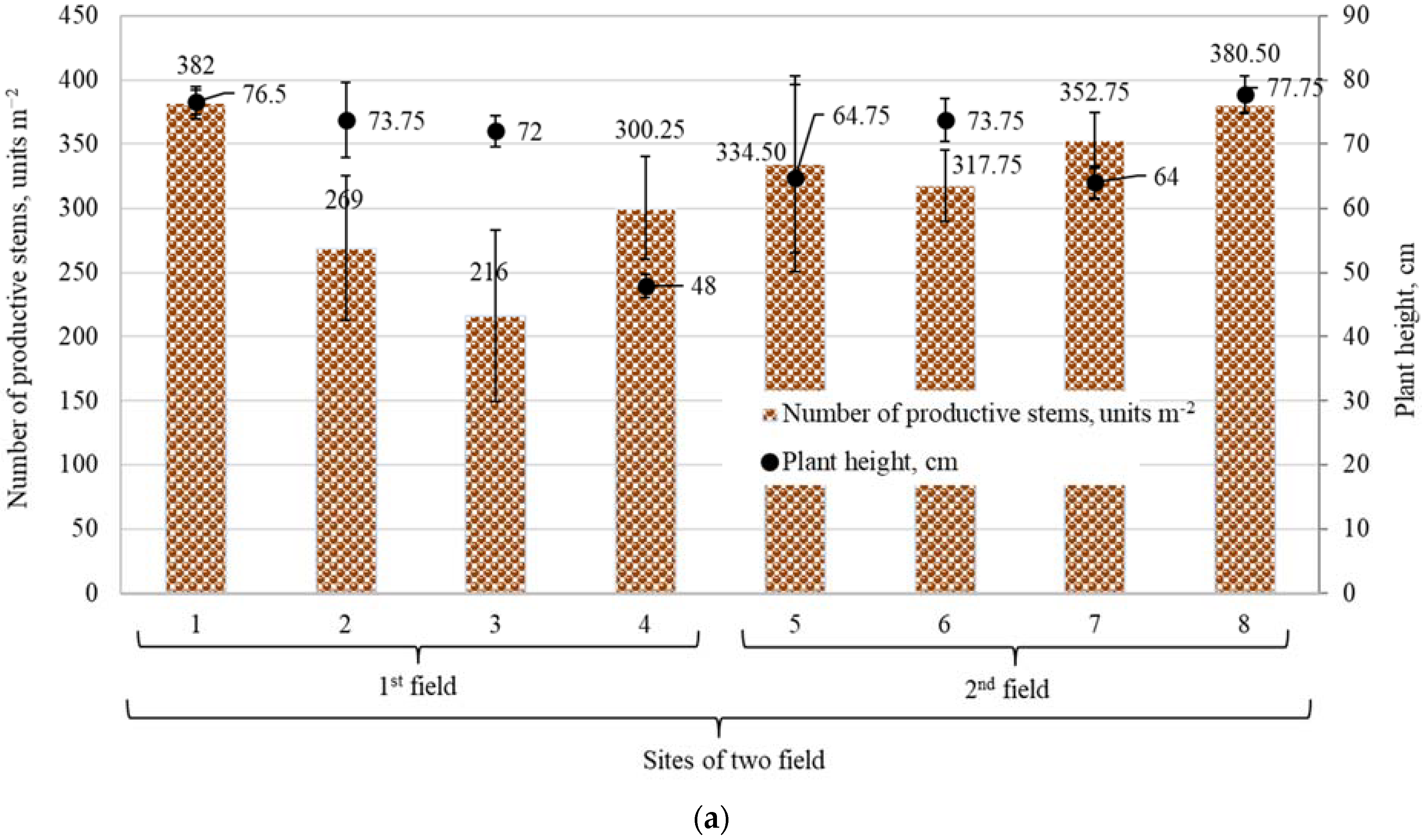
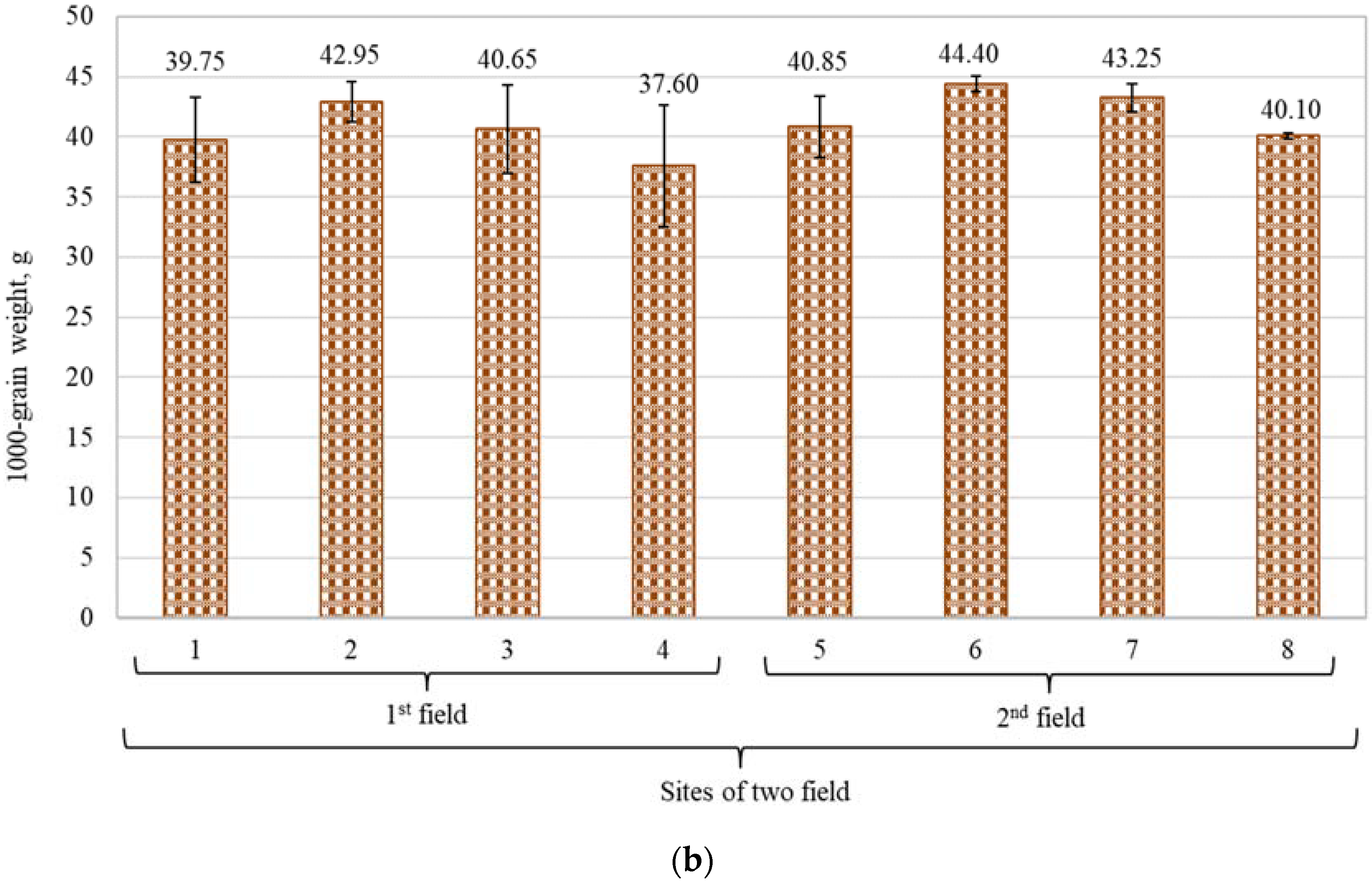
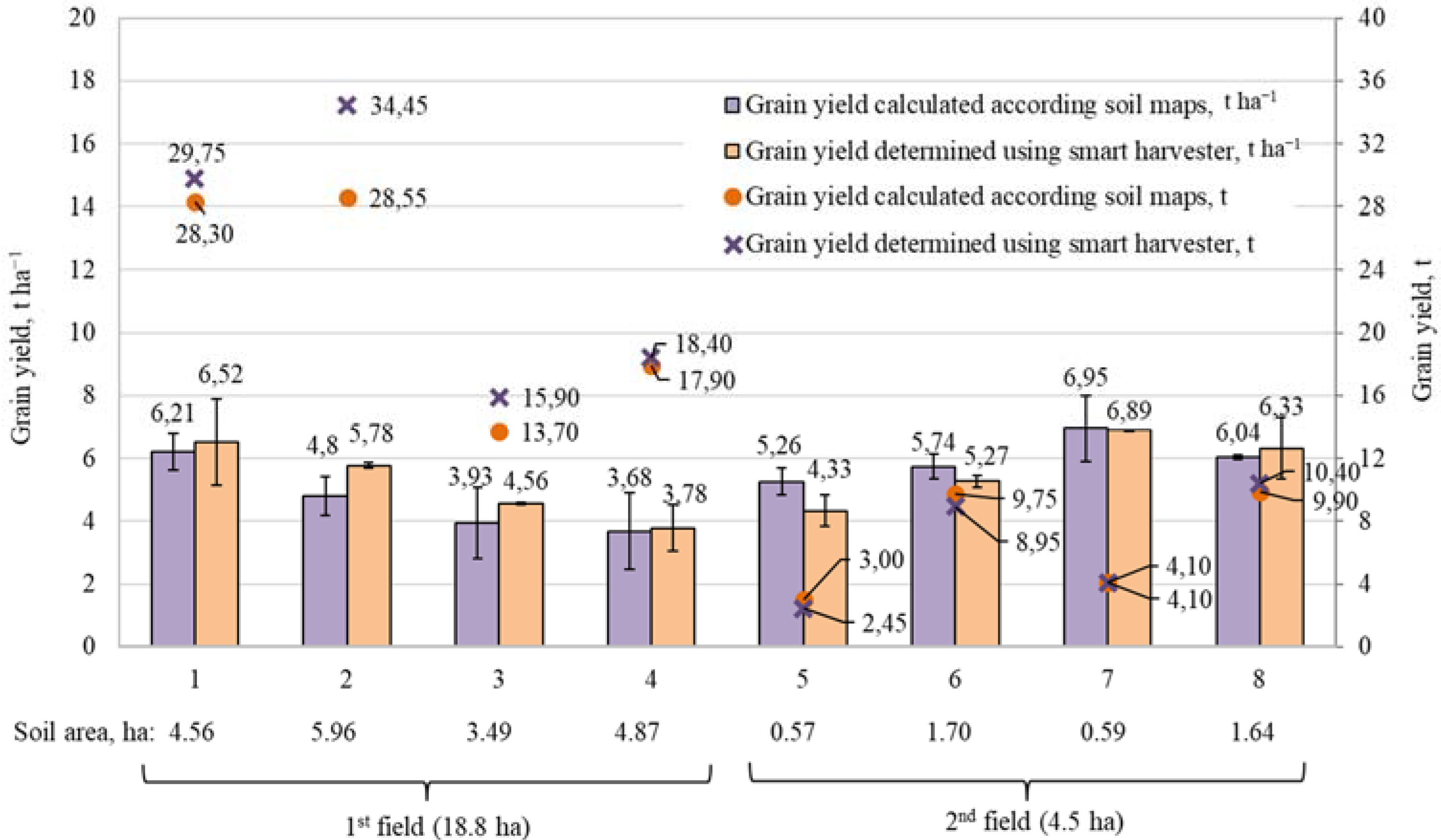
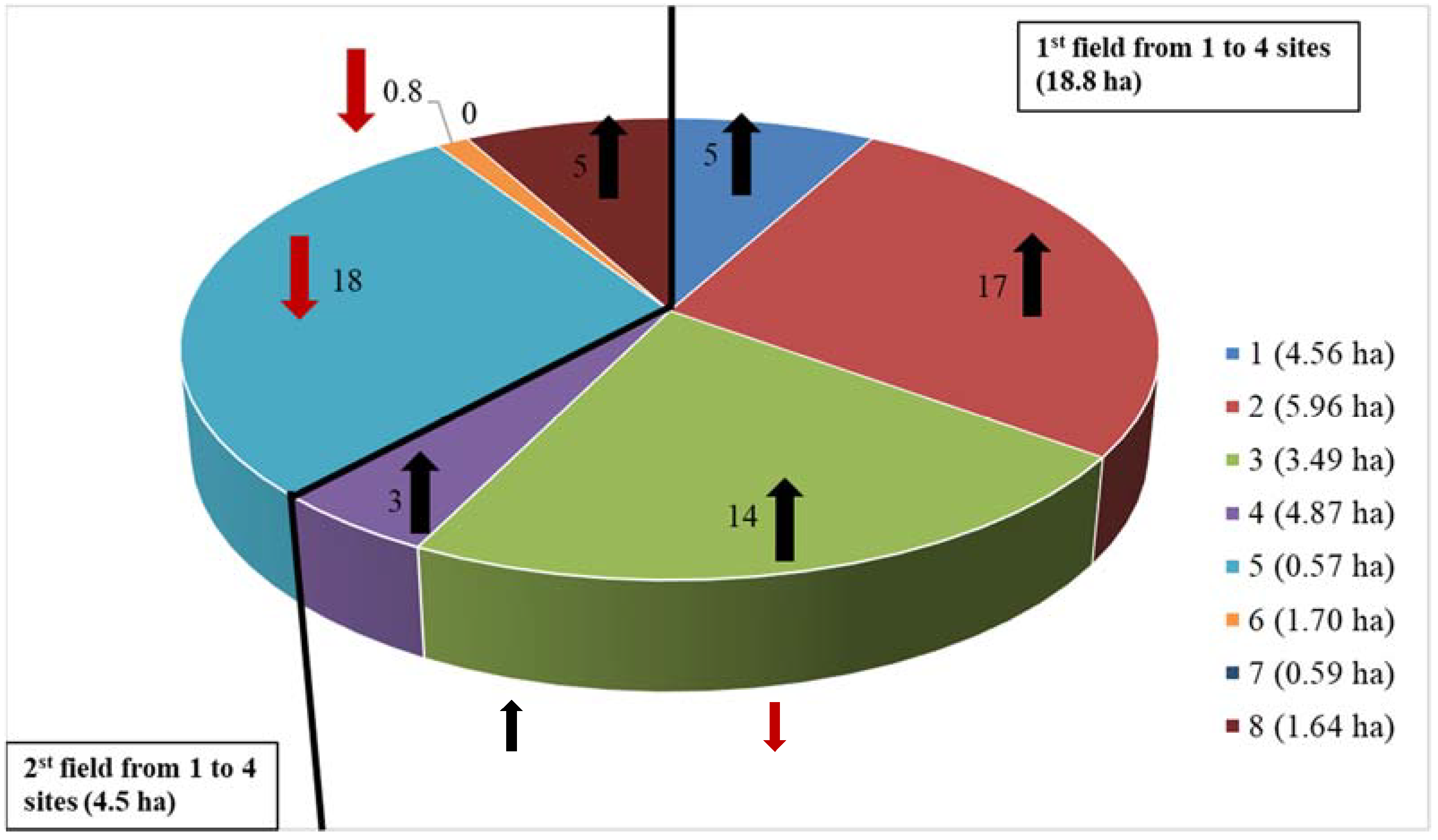
| Field No. | Field Area, ha | Soil (FAO) | Soil Texture: Topsoil/Subsoil |
|---|---|---|---|
| First field | |||
| 1 | 4.56 | Haplic Luvisols | Silt loam/silt loam |
| 2 | 5.96 | Haplic Luvisols | Silt loam/silt loam |
| 3 | 3.49 | Eutric Gleysols | Sandy loam/sandy loam |
| 4 | 4.87 | Haplic Arenosols | Sandy loam/sand |
| 18.8 | |||
| Second field | |||
| 5 | 0.57 | Eutric Gleysols | Sandy loam/sandy loam |
| 6 | 1.70 | Eutric Planosols | Sandy loam/sandy loam/silty clay loam |
| 7 | 0.59 | Haplic Luvisols | Sandy loam/loam |
| 8 | 1.64 | Haplic Luvisols | Sandy loam/loam |
| 4.5 | |||
| Indicators | Months | |||||||||||
|---|---|---|---|---|---|---|---|---|---|---|---|---|
| 09 | 10 | 11 | 12 | 01 | 02 | 03 | 04 | 05 | 06 | 07 | 08 | |
| Monthly Average Daily Temperature, °C | ||||||||||||
| 2018–2019 | 15.2 | 8.9 | 2.7 | −1.1 | −4.2 | 1.1 | 3.4 | 9.2 | 13.5 | 21.2 | 17.3 | 18.5 |
| 2019–2020 | 13.3 | 9.6 | 5.0 | 2.5 | 2.2 | 2.2 | 3.8 | 7.0 | 10.8 | 19.6 | 18.1 | 18.9 |
| SCN * | 13.9 | 7.8 | 3.7 | 0.1 | −3.6 | −2.1 | 1.8 | 8.0 | 14.0 | 18.1 | 18.8 | 18.5 |
| Monthly Precipitation, mm | ||||||||||||
| 2018–2019 | 22 | 27.6 | 12.4 | 40.5 | 31.3 | 20.6 | 31.3 | 0.1 | 10.7 | 25.5 | 44.3 | 56.4 |
| 2019–2020 | 40.5 | 37 | 32.8 | 22.3 | 38.6 | 39.5 | 21 | 6.4 | 60.1 | 79.4 | 54. | 76.8 |
| SCN * | 45.4 | 44.8 | 41.8 | 44.7 | 39.6 | 29.6 | 27.5 | 33.1 | 50.7 | 51.2 | 100.4 | 74.3 |
| Field No. | Field Area, ha | Soil (FAO) | Soil Texture: Topsoil/Subsoil | pHKCl | Available P2O5, mg kg−1 | Available K2O, mg kg−1 | Humus % |
|---|---|---|---|---|---|---|---|
| First field | |||||||
| 1 | 4.56 | Haplic Luvisols | Silt loam/silt loam | 7.05 | 794.5 | 216.0 | 2.46 |
| 2 | 5.96 | Haplic Luvisols | Silt loam/silt loam | 6.60 | 385.0 | 175.0 | 2.09 |
| 3 | 3.49 | Eutric Gleysols | Sandy loam/sandy loam | 6.85 | 487.0 | 161.0 | 2.32 |
| 4 | 4.87 | Haplic Arenosols | Sandy loam/sand | 6.50 | 659.0 | 287.5 | 2.18 |
| x/median | 6.75/6.73 | 683.7/573.0 | 220.1/216.0 | 2.26/2.25 | |||
| min/max | 6.05/7.05 | 385.0/1204.0 | 161.0/287.5 | 2.09/2.46 | |||
| σ/CV, % | 0.25/3.68 | 364.80/53.35 | 61.51/27.94 | 0.16/7.27 | |||
| Second field | |||||||
| 5 | 0.57 | Eutric Gleysols | Sandy loam/sandy loam | 6.70 | 707.0 | 210.5 | 2.97 |
| 6 | 1.70 | Eutric Planosols | Sandy loam/sandy loam/silty clay loam | 6.85 | 790.5 | 181.0 | 3.44 |
| 7 | 0.59 | Haplic Luvisols | Sandy loam/loam | 6.60 | 635.0 | 175.0 | 2.16 |
| 8 | 1.64 | Haplic Luvisols | Sandy loam/loam | 6.95 | 715.7 | 167.5 | 1.94 |
| x/median | 6.78/6.78 | 732.2/748.7 | 181.6/178.2 | 2.63/2.56 | |||
| min/max | 6.60/6.95 | 635.0/796.5 | 159.5/178.2 | 1.94/3.44 | |||
| σ/CV, % | 0.16/2.29 | 76.63/10.46 | 21.30/11.73 | 0.70/26.76 | |||
Publisher’s Note: MDPI stays neutral with regard to jurisdictional claims in published maps and institutional affiliations. |
© 2022 by the authors. Licensee MDPI, Basel, Switzerland. This article is an open access article distributed under the terms and conditions of the Creative Commons Attribution (CC BY) license (https://creativecommons.org/licenses/by/4.0/).
Share and Cite
Astrauskas, P.; Staugaitis, G. Digital Technologies Determination Effectiveness for the Productivity of Organic Winter Wheat Production in Low Soil Performance Indicator. Agriculture 2022, 12, 474. https://doi.org/10.3390/agriculture12040474
Astrauskas P, Staugaitis G. Digital Technologies Determination Effectiveness for the Productivity of Organic Winter Wheat Production in Low Soil Performance Indicator. Agriculture. 2022; 12(4):474. https://doi.org/10.3390/agriculture12040474
Chicago/Turabian StyleAstrauskas, Paulius, and Gediminas Staugaitis. 2022. "Digital Technologies Determination Effectiveness for the Productivity of Organic Winter Wheat Production in Low Soil Performance Indicator" Agriculture 12, no. 4: 474. https://doi.org/10.3390/agriculture12040474
APA StyleAstrauskas, P., & Staugaitis, G. (2022). Digital Technologies Determination Effectiveness for the Productivity of Organic Winter Wheat Production in Low Soil Performance Indicator. Agriculture, 12(4), 474. https://doi.org/10.3390/agriculture12040474





